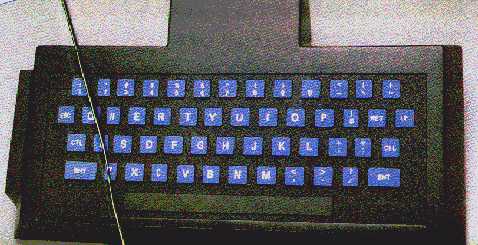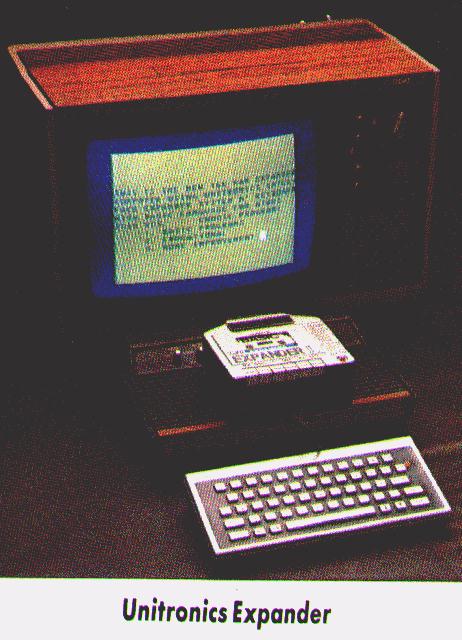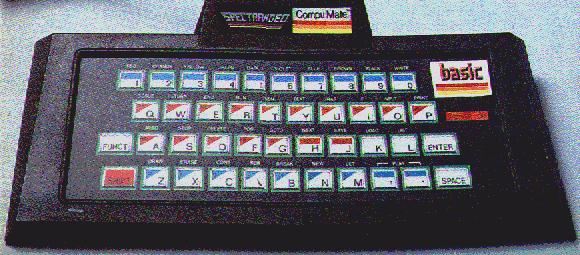
You love your Atari VCS, but want a computer too. A solution is at hand. At least four companies have announced that they're going to be making a keyboard attachment to turn your Atari 2600 video game system into a home computer. And get this: They're selling for as little as $90.

Let's talk first about Atari's entry into the field--The Atari 2600 Computer. It won't be out until September, but from what we know now, it may be worth waiting for.
The unit consists of a keyboard with a built-in microprocessor. Installation is a snap. You simply plug the keyboard attachment into the slot where you now insert game cartridges. And you don't ever have to remove it if you don't want to. (The keyboard has a slot where you can plug in game cartridges.) After you install the attachment, you have a machine that does everything your VCS has always done--namely, play video games--and is a powerful computer as well.
You might be saying--Big deal. Why do I need a computer? Well, maybe you don't. But Atari is also bringing out a new line of game cartridges that will play only through the computer attachment. These new games will be more sophisticated (better graphics, more screens) than the ones you're presently playing on your VCS. And you'll also have a full-function computer at your call when and if you decide you need it.
A computer this powerful just years ago would have cost as much as $1000. Today, for less than $100, your video game machine becomes an 8K RAM computer with an 8K built-in Microsoft BASIC. It will be able to maintain your Christmas card list, catalog your tapes, games, or records, help you learn typing and speed reading, and enable you to create pictures and music.
One of the great thrills with a computer is when you program your first game. Don't expect to sit down the first week and create another Donkey Kong. That's a very complicated program. But if you follow the instruction manual carefully and spend a few hours a week practicing programming, you'll soon be able to write pong-type games. The next step is games like Breakout. After that, you're limited only by the capabilities of your computer and your imagination.
You write your games or other programs by typing out the list of instructions on the keyboard. To save the program, you use an ordinary cassette tape recorder which you've connected to the computer with a cable supplied by Atari. Later, if you want to make some change in the program, or if yoll want to run it as is, you simply play the tape containing the program and it gets loaded into the computer's memory. You then type the word RUN and the program runs.
Some more details on My First Computer: It will be an incredible graphics machine, with 128 colors. There will be 16 basic colors, each of which can be displayed in eight different shades. (The Atari 400 and 800 computers can display 256 colors.) For graphics, there is no machine in the price range that comes close.
The 8K RAM memory that comes with the machine is expandable up to 32K, so if you get heavily into computing and need more memory, the option is there to add it. Again, if you get heavily into computing, you'll find cassette tape a rather slow way to save and load programs. Either floppy disks or wafer tapes will be offered as an alternative method of program storage. A low cost printer will be available as well.
It's interesting to wonder how Imagic, Activision, and other companies will respond to the upgraded VCS. Once their engineers figure out all the new circuitry in the keyboard converter, they'll be just as capable as Atari of creating new lines of super-games for the super VCS.
How will the market change? Will new games be released in two versions? Or will so many people upgrade their VCS to a 2600 Computer that present-style VCS games will no longer be manufactured?

A company called Entex is also bringing out a computer add-on for the VCS, called the Piggyback. The name is slightly misleading because, unlike the Atari add-on, the unit does not rest on top of the VCS. It's connected by means of an "umbilical cord" and actually sits in front of the game machine.
The most striking feature of the Piggyback is its superb keyboard, which has a professional look and a lovely touch (Atari's keys are made of elastometric rubber and more closely resemble the keys of a calculator than those of a typewriter.)
The Piggyback has less memory than the Atari (3K vs. 8K). Its built- in BASIC language is somewhat restricted, and it cannot use a tape recorder to load and save programs. However, an expansion module takes care of all these limitations. It adds 16K of RAM, extends the BASIC and adds cassette capabilities. Like the Atari, the Entex will have a broad range of software for home management and for education, supplied in the form of snap-in cartridges.
Unfortunately, the graphics of the Piggyback don't nearly approach those of the Atari. If you think of the video screen as a piece of graph paper, the Entex consists of only 512 squares, while the Atari consists of 30,720 squares. Obviously the Entex can produce only block-style graphics, while the Atari has enough pixels (squares) to render images with considerable detail.
The Entex has 16 graphic characters--lines, bars, boxes and so forth. By combining these creatively, it's possible to get some interesting effects. However, the characters weren't really meant for doing computer art. They're most useful for constructing bar charts and other types of graphs.
The Entex will cost $130 and the expansion module $60. The system can be further expanded with additional memory, a printer and a modem.

The third company offering a VCS expander is Unitronics, and its product, appropriately enough, is The Expander. Unfortunately, as we went to press, the company was engaged in an extensive redesign of its unit, so we can't offer you very many details.
What we know is this: There are really two products--the Expander and the Keyboard. The Expander is something like the Arcadia Supercharger. It's a cassette deck which sits atop the VCS, and it contains chips which expand the memory of the VCS to 16K.
VCS cartridges played through the Expander play just as they've always played, but games specifically designed for the Expander can take advantage of the additional memory to produce striking graphics and enhanced game play. The games are supplied on cassette tape. Cassettes cost much less than cartridges.
To turn the Expander into a computer, you plug in the Keyboard. When you purchase the Keyboard, you also get a cassette tape which contains the BASIC programming language. We're unable to say right now how this version of BASIC compares to Atari's and Entex's.

Here are a few details about Spectravision's entry into the market of VCS computer converters. The CompuMate has a flat keyboard, which means you can't press down the keys. You "type" by simply touching the keys. It's hardly the ideal keyboard.
A nice feature is single touch enter of BASIC keywords. Above the "P" key is the word PRINT. Above the "L" key is the word LIST. You simply touch the key and the entire BASIC keyword is printed out on the screen.
Many of the keys have musical symbols on them, since the unit has a built-in music composer program. The system also comes with a built-in Magic Easel program for drawing pictures with a joystick. There are eight colors plus black and white. Suggested retail on CompuMate is $99.95.
So it's shaping up to be a four-way contest, and you, the consumer, can only benefit from the competition. For one thing, it means that prices will prohahly drop. It also means that you have to do some careful comparison shopping to decide which of these products best suits your needs.
Actually, your choice is somewhat wider than just Atari, Entex, Unitronics, and Spectravision. A number of other computers sell in the same price range. There's the Timex Sinclair 1000, which startled the world last year when it came to market at $99. The Timex is presently being sold for as little as $40. Unfortunately, it has a tiny keyboard which will cramp up your fingers, a tiny RAM of 2K, and no sound or color.
The Texas Instruments 99/2 sells for $99. If you didn't own a VCS and were looking for a good first computer, this would be a fine choice. But it's more expensive than Atari's keyboard enhancer and it has no sound or color.
For many people, the real competition to the Atari add-on is the Commodore VIC-20. More than a million of these computers have been sold, and right now the product is very hot. I'm not recommending one computer over the other, but I'm suggesting a very careful comparison. If the price of the VIC-20 should drop to $100 or so, then it merits your consideration. The VIC-20 has only a 5K RAM compared with Atari's 8K, but it has a typewriter keyboard that many people will find more comfortable. There are tradeoffs here. You'll have access to a huge library of VIC software, but you won't be able to play Atari's new line of cartridges for the expanded VCS.
All these goodies will be making themselves known to you through massive advertising campaigns. Advertising is okay, but your best strategy is to get hands-on experience with the products, which will be widely distribnted in department stores, toy stores, and chain stores.
So, if you love your VCS but want a computer too, a solution is now at hand. Whatever you choose, good luck with your first computer.
[Scanned and edited by Dennis Brown, dgbrown (at) pixesthesia (dot) com]